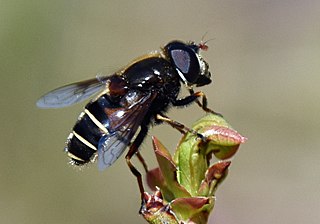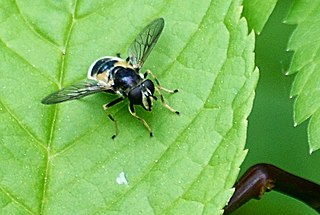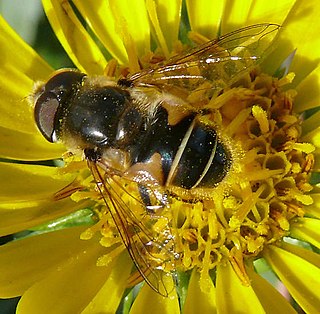
The genus Chrysotoxum consists of large, wasp-mimicking species. The adults are distinguished by very long antennae, oval abdomen with yellow stripes, and yellow patterns on the thoracic pleurae . The species of Chrysotoxum are chiefly Holarctic in distribution. . The species in this genus, are mostly very uniform in structure and colour and are separated with difficulty. Larvae are specialized in preying upon root aphids associated with ant nests.

Eristalis cryptarum is a holarctic species of hoverfly. Known as the bog hoverfly or bog-dwelling drone fly, it is a bog specialist but may occur in other wetlands. Its larvae are assumed to live in peat that is saturated with water, such as that found in these boggy areas. The female has been observed depositing eggs on and close to very fresh cow dung along oligotrophic seepages in moorland.

Nemotelus nigrinus, the all-black snout, is a Holarctic species of soldier fly.
Dipteran morphology differs in some significant ways from the broader morphology of insects. The Diptera is a very large and diverse order of mostly small to medium-sized insects. They have prominent compound eyes on a mobile head, and one pair of functional, membraneous wings, which are attached to a complex mesothorax. The second pair of wings, on the metathorax, are reduced to halteres. The order's fundamental peculiarity is its remarkable specialization in terms of wing shape and the morpho-anatomical adaptation of the thorax – features which lend particular agility to its flying forms. The filiform, stylate or aristate antennae correlate with the Nematocera, Brachycera and Cyclorrhapha taxa respectively. It displays substantial morphological uniformity in lower taxa, especially at the level of genus or species. The configuration of integumental bristles is of fundamental importance in their taxonomy, as is wing venation. It displays a complete metamorphosis, or holometabolous development. The larvae are legless, and have head capsules with mandibulate mouthparts in the Nematocera. The larvae of "higher flies" (Brachycera) are however headless and wormlike, and display only three instars. Pupae are obtect in the Nematocera, or coarcate in Brachycera.

Brachyopa flavescens, The Yellow Sapeater, is a fairly common species of syrphid fly. It has been observed in northeastern North America. Hoverflies get their names from the ability to remain nearly motionless while in flight. The adults are also known as flower flies for they are commonly found around and on flowers, from which they get both energy-giving nectar and protein-rich pollen. Larvae for this genus are of the rat-tailed type. B.flavescens larvae have not been described.
Blera nigra , the Golden Haired Wood Fly, is a fairly common species of syrphid fly first officially described by Williston in 1887 Hoverflies get their name from the ability to remain nearly motionless while in flight The adults are also known as flower flies for they are commonly found around and on flowers from which they get both energy-giving nectar and protein rich pollen. The larvae are of the rat-tailed type feeding on exuding sap or in the rot holes of trees.
Orthonevra flukei (Sedman, 1966), Fluke's Mucksucker, is an uncommon species of syrphid fly It has been observed in the Western United States. Hoverflies get their names from the ability to remain nearly motionless while in flight. The adults are also known as flower flies for they are commonly found around and on flowers from which they get both energy-giving nectar and protein-rich pollen. Larvae for this genus are of the rat-tailed type. O. flukei larvae have been described.

Orthonevra pictipennis (Loew,1863), the Dusky-veined Mucksucker, is an uncommon species of syrphid fly. It has been observed in North America. O. pictipennis shares much of the same range as O. pulchella, O. nitida and O. feei. Hoverflies get their names from the ability to remain nearly motionless while in flight. The adults are also known as flower flies, for they are commonly found around and on flowers from which they get both energy-giving nectar and protein-rich pollen. Larvae for this genus are of the rat-tailed type. O. pictipennis larvae have not been described.

Helophilus lapponicus, the Yellow-margined Marsh Fly, is a common species of syrphid fly observed across northern North America, northern Europe, Greenland and Siberia. Hoverflies can remain nearly motionless in flight. The adults are also known as flower flies for they are commonly found on flowers, from which they get both energy-giving nectar and protein-rich pollen. Though common the larvae of this species are not known but the larvae of other species in this genus are associated with wet decaying organic material, particularly accumulations of decaying vegetation in ponds and mud and are a so called rat-tailed type.
Microdon tristis is a species of syrphid fly in the family Syrphidae.

Arctosyrphus willingii, the northern longbeak, is a species of rat-tail maggot fly in the family Syrphidae. This species was formerly a member of the genus Lejops.
Hadromyia aepalius, the Sterling Quicksilver, is a rare species of syrphid fly found in eastern North America. Hoverflies get their names from the ability to remain nearly motionless while in flight. The adults are also known as flower flies for they are commonly found around and on flowers, from which they get both energy-giving nectar and protein-rich pollen.

Blera pictipes, the Painted Wood Fly, is a rare species of syrphid fly first officially described by Bigot in 1883. Hoverflies get their names from the ability to remain nearly motionless while in flight. The adults are also known as flower flies for they are commonly found around and on flowers, from which they get both energy-giving nectar and protein-rich pollen. The larvae are of the rat-tailed type, feeding on exuding sap or in the rot holes of trees.

Brachyopa daeckei, the black-tailed sapeater, is a rare species of syrphid fly that has been observed in northeastern North America. Hoverflies get their names from the ability to remain nearly motionless while in flight. The adults are also known as flower flies for they are commonly found around and on flowers, from which they get both energy-giving nectar and protein-rich pollen. Larvae for this genus are of the rat-tailed type. B.daeckei larvae have not been described.

'Blera confusa , the confusing Wood Fly, is a common species of syrphid fly first officially described by Johnson, 1913 Hoverflies get their names from the ability to remain nearly motionless while in flight. The adults are also known as flower flies for they are commonly found around and on flowers, from which they get both energy-giving nectar and protein-rich pollen. The larvae are of the rat-tailed type feeding on exuding sap or in the rot holes of trees.

Blera scitula, the Western Wood Fly, is an uncommon species of syrphid fly first officially described by Williston in 1882. Hoverflies get their names from the ability to remain nearly motionless while in flight. The adults are also known as flower flies, for they are commonly found around and on the flowers from which they get both energy-giving nectar and protein-rich pollen. The larvae of Blera are of the rat-tailed type, feeding on exuding sap or in the rot holes of trees.

Eristalis hirta, the black-footed drone fly, is a common Western North American species of syrphid fly, first officially described by Loew in 1866. Hoverflies get their names from the ability to remain nearly motionless while in flight. The adults are also known as flower flies as they are commonly found on and around flowers, from which they get both energy-giving nectar and protein-rich pollen. The larvae are aquatic filter-feeders of the rat-tailed type.
Neoascia globosa , the Black-margined Fen , is a fairly common species of syrphid fly observed in northeastern North America. Hoverflies can remain nearly motionless in flight. The adults are also known as flower flies, for they are commonly found on flowers from which they get both energy-giving nectar and protein-rich pollen. The larvae are aquatic.

Brachyopa caesariata, the Plain-winged Sapeater, is an uncommon species of syrphid fly. It has been observed in Canada, Alaska and northern United States. Hoverflies get their names from the ability to remain nearly motionless while in flight. The adults are also known as flower flies for they are commonly found around and on flowers, from which they get both energy-giving nectar and protein-rich pollen. Larvae for this genus are of the rat-tailed type. B.caesariata larvae have not been described.

Brachyopa diversa , the Pale-striped Sapeater, is a rare species of syrphid fly. It has been observed in the northeastern part of North America. Hoverflies get their names from the ability to remain nearly motionless while in flight. The adults are also known as flower flies for they are commonly found around and on flowers, from which they get both energy-giving nectar and protein-rich pollen. Larvae for this genus are of the rat-tailed type. B.diversa larvae have not been described.














